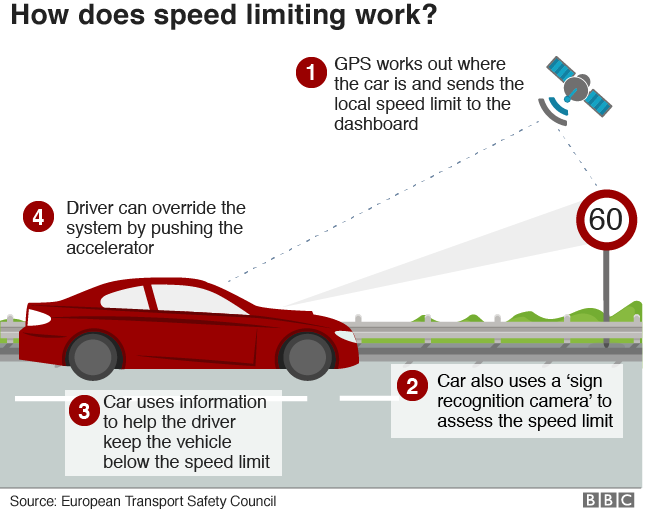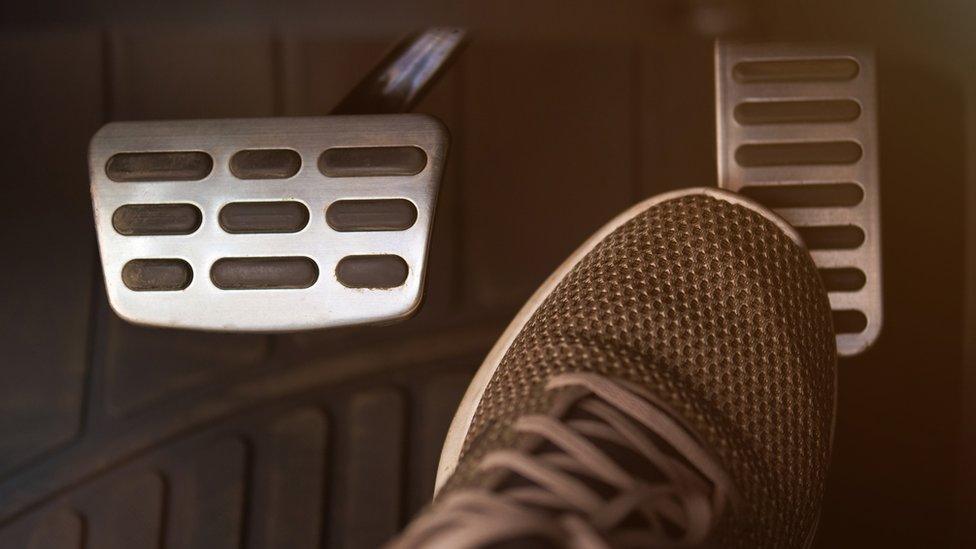Are speed limiters the best way to reduce road deaths?
- Published

Does such driver assistive technology actually make us less attentive drivers?
The European Union is planning to make speed limiters compulsory on all new cars from 2022 and the UK is set to follow suit even after Brexit. But is the technology reliable enough yet?
It is certainly disconcerting at first: you're happily driving along a country road at 60mph (97km/h) when a speed limit sign on the dashboard starts blinking irritably and your car begins to slow down, all by itself.
This is what it feels like to use an intelligent speed assistance system (ISA). Or at least, it's what it feels like if you fail to spot a speed restriction sign and are about to go sailing through a small village at close to double the 30mph limit.
The car will also make sure that as you pass through the village your speed stays down. It does this not by automatically applying the brakes - that's emergency assistive braking - but by limiting the engine power. If your speed does creep up for any reason an insistent electronic chime will alert you.
New technology will make it easier to stick to speed limits
Systems like this are already available on a number of new cars, although they will only work if you take the trouble to switch them on.
But they will soon become a lot more common, because the European Union is planning to make them compulsory on all new cars from 2022. The European Transport Safety Council has long advocated their use, citing studies suggesting they are the most effective life-saving driver assistance systems.
The Department for Transport has said the same rules will apply in the UK, even once we have left the EU.
In fact, the EU has set out a much wider range of compulsory safety measures that will have to be fitted to all cars from that date, including emergency automatic braking, lane-keeping assistance and systems to prevent drivers from becoming drowsy or distracted.
Misconceptions
But none has so far proved nearly as divisive as ISA, or has generated as many headlines. That's because ISA limits speed and the very idea of compulsory speed limiters is something many drivers object to.
Supporters of the plan claim there are misconceptions around what ISA is and what it actually does.

Would speed limiters mean an end to speeding fines?
"Most people want to stick to the speed limit but they need help in understanding what the speed limit is for any particular road. These systems will help them do that," says Matthew Avery of Thatcham Research, an organisation that carries out testing on behalf of the insurance industry.
In other words it's meant to be a driver aid rather than an excuse to put Big Brother behind the wheel. Nevertheless, according to the European Transport Safety Council, with mass adoption it could have major safety benefits, potentially cutting collisions by 30% and deaths on the road by 20%.
How it works
To regulate speed the car needs to know what the limit is in a given area, Currently this can be done in two ways:
Firstly, it is possible to use GPS satellite navigation technology to work out exactly where the car is and where it is heading, and compare that to a mapping database on which the different speed limits are recorded.
The advantage of a system like this is that not only does it know what the limit is on the stretch of road you're actually using, it can warn you of upcoming limits as well.

But it is only as good as the database it relies on. If the information provided is out of date or incomplete - a temporary speed limit may be in place during road works, for example - it cannot keep the driver properly informed.
The alternative is to use a camera and software that can "read" the speed limit signs themselves. This allows the onboard computer to respond to variable limits and short-term speed restrictions.
But it is essentially a reactive mechanism and cannot warn the driver of what lies further ahead.
The most logical solution would be to have a combination of both systems.
That might sound like a recipe for high costs but according to Roland Schaefer, a safety expert at Ford of Europe, many cars are already equipped with the hardware they need.

Many of us are too heavy with the right foot when driving, are speed limiters the answer?
"If you already have GPS navigation, if you already have a camera on the car, then all you need is software. Quite complicated but still just software," he says.
Prof Oliver Carsten of Leeds University's Institute for Transport Studies agrees. An expert on transport safety, he was involved in a major six-year study into ISA that was funded by the UK government.
"Initially we estimated the probable costs at about £2,000 per vehicle," he says. "But now the extra costs are negligible because if you already have things like lane departure warnings fitted you already have a camera on your car."
Imperfect solution?
But while the technology may be affordable right now it is far from perfect. One of the cars we drove, for example, became confused when it passed two signs giving different speed limits and failed to respond to either.
"If you have conflicting information, for example your GPS map tells you one thing and your camera tells you another, which do you go with? It's not always possible to be wholly accurate," says Ford's Roland Schaefer.
One possible solution is "vehicle-to-infrastructure communication", he thinks, where speed limit signs, traffic lights and other street furniture would be able to transmit signals directly to the car via a 5G connection, for example.


But for such a system to work, it needs to be standardised so that all manufacturers use the same type of technology - and someone has to install and pay for it. That, Mr Schaefer says, is a problem for governments and policymakers.
In the meantime compulsory intelligent speed assistance is on its way. But it comes with an important caveat: the driver will be able to override the system at all times. There are good reasons for this.
"One issue is acceptance," says Prof Carsten. "We don't want to be turning off public support. The other issue is unreliability - what happens if the car accidentally picks up a limit that's much too low, on a fast road? It could be a serious safety issue."
Roland Schaefer agrees.
"We bring in new technology if we think it can help our customers," he says. "We don't want to overrule the driver. He must always have the last word".
Follow Technology of Business editor Matthew Wall on Twitter, external and Facebook, external